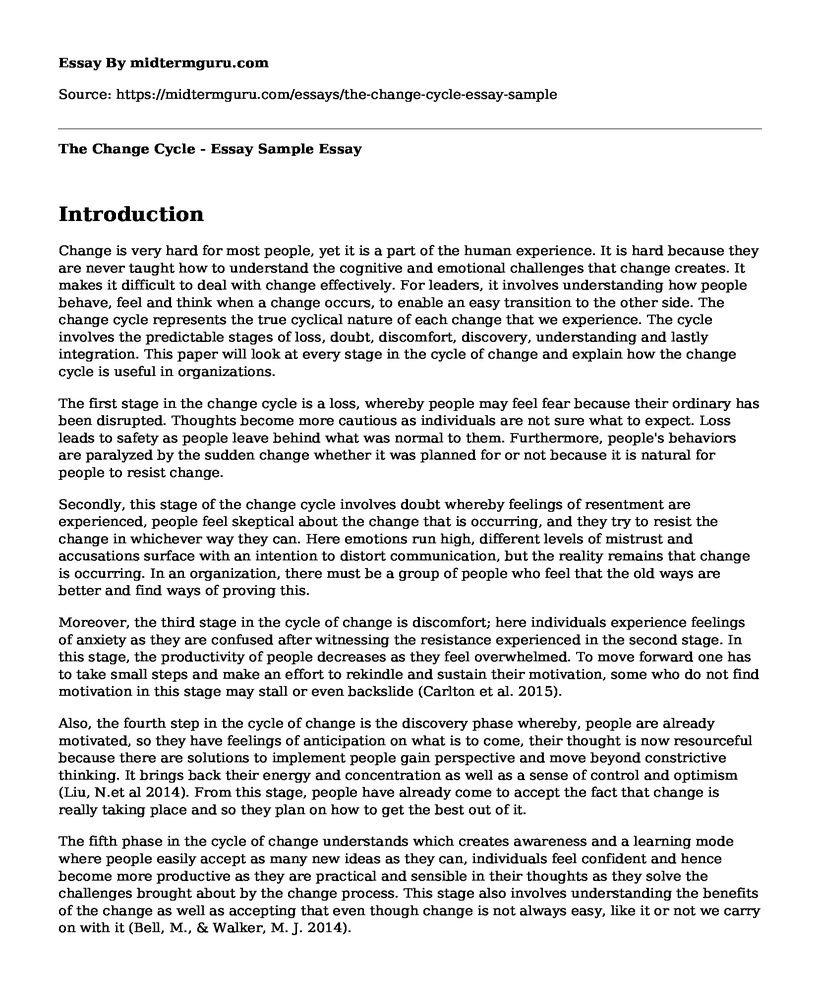Introduction
Change is very hard for most people, yet it is a part of the human experience. It is hard because they are never taught how to understand the cognitive and emotional challenges that change creates. It makes it difficult to deal with change effectively. For leaders, it involves understanding how people behave, feel and think when a change occurs, to enable an easy transition to the other side. The change cycle represents the true cyclical nature of each change that we experience. The cycle involves the predictable stages of loss, doubt, discomfort, discovery, understanding and lastly integration. This paper will look at every stage in the cycle of change and explain how the change cycle is useful in organizations.
The first stage in the change cycle is a loss, whereby people may feel fear because their ordinary has been disrupted. Thoughts become more cautious as individuals are not sure what to expect. Loss leads to safety as people leave behind what was normal to them. Furthermore, people's behaviors are paralyzed by the sudden change whether it was planned for or not because it is natural for people to resist change.
Secondly, this stage of the change cycle involves doubt whereby feelings of resentment are experienced, people feel skeptical about the change that is occurring, and they try to resist the change in whichever way they can. Here emotions run high, different levels of mistrust and accusations surface with an intention to distort communication, but the reality remains that change is occurring. In an organization, there must be a group of people who feel that the old ways are better and find ways of proving this.
Moreover, the third stage in the cycle of change is discomfort; here individuals experience feelings of anxiety as they are confused after witnessing the resistance experienced in the second stage. In this stage, the productivity of people decreases as they feel overwhelmed. To move forward one has to take small steps and make an effort to rekindle and sustain their motivation, some who do not find motivation in this stage may stall or even backslide (Carlton et al. 2015).
Also, the fourth step in the cycle of change is the discovery phase whereby, people are already motivated, so they have feelings of anticipation on what is to come, their thought is now resourceful because there are solutions to implement people gain perspective and move beyond constrictive thinking. It brings back their energy and concentration as well as a sense of control and optimism (Liu, N.et al 2014). From this stage, people have already come to accept the fact that change is really taking place and so they plan on how to get the best out of it.
The fifth phase in the cycle of change understands which creates awareness and a learning mode where people easily accept as many new ideas as they can, individuals feel confident and hence become more productive as they are practical and sensible in their thoughts as they solve the challenges brought about by the change process. This stage also involves understanding the benefits of the change as well as accepting that even though change is not always easy, like it or not we carry on with it (Bell, M., & Walker, M. J. 2014).
The last step in the cycle of change is experiencing integration; this ultimately enables flexibility after uncertainty. Here, individuals feel satisfied and become more focused on doing better than before as the change has become a part of their lives. People become generous and freely help those who may not have coped well with the change for a various reason; this is the last step after which the change becomes the new normal (Shimura, T., et al 2014).
The most organizations that are resilient to change have been found to move closer to achieving their goals since they perceive change is a part of every organization's life. The change cycle is used to develop new strategies, culture, and way of operation to ensure efficiency and appropriate resource utilization (Stocker et al. 2013).
Conclusion
In conclusion, change is very important not only in everyday life but also in organizations, those who do not accept change are at risk of being labeled irrelevant. Dynamics is part and parcel of the human experience and should be embraced however difficult it is.
References
Bell, M., & Walker, M. J. (2014). Late Quaternary environmental change: physical and human perspectives. Routledge.
Carlton, B., & Russell, E. (2015). 'A Gender for Change'. Cycles of Women's Penal Reform and Reconfigurations of Anti-Prison Resistance in Victoria, Australia. Champ penal/Penal field, 12.
Liu, N., Lu, Z., Zhao, J., McDowell, M. T., Lee, H. W., Zhao, W., & Cui, Y. (2014). A pomegranate-inspired nanoscale design for large-volume-change lithium battery anodes. Nature nanotechnology, 9(3), 187.
Shimura, T., Jiao, Z., Hara, S., & Shikazono, N. (2014). Quantitative analysis of solid oxide fuel cell anode microstructure change during redox cycles. Journal of Power Sources, 267, 58-68.
Stocker, T. (Ed.). (2014). Climate change 2013: the physical science basis: Working Group I contribution to the Fifth assessment report of the Intergovernmental Panel on Climate Change. Cambridge University Press.
Cite this page
The Change Cycle - Essay Sample. (2022, Sep 07). Retrieved from https://midtermguru.com/essays/the-change-cycle-essay-sample
If you are the original author of this essay and no longer wish to have it published on the midtermguru.com website, please click below to request its removal:
- Annotated Bibliography on Treatment of Post-Traumatic Stress Disorder - Paper Example
- Essay on Drugs Abuse and Teenage Love
- Research Paper on Concept of Procrastination
- Physical Activity and Inactivity on Oxidative Stress - Paper Example
- Adolescence Socio-Emotional Development: Challenges & Solutions - Essay Sample
- Jose Depression - Case Study
- Literary Analysis Essay on "Civilization and Its Discontents" and "A Room of One's Own"







